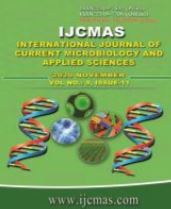


 National Academy of Agricultural Sciences (NAAS)
National Academy of Agricultural Sciences (NAAS)

|
PRINT ISSN : 2319-7692
Online ISSN : 2319-7706 Issues : 12 per year Publisher : Excellent Publishers Email : editorijcmas@gmail.com / submit@ijcmas.com Editor-in-chief: Dr.M.Prakash Index Copernicus ICV 2018: 95.39 NAAS RATING 2020: 5.38 |
Mapping of land use land cover (LULC) rehearses in the Himalayas is indispensable for sustainable development, planning and management of resources. In light of remote sensing (RS) and geographic information system (GIS) techniques, the study is an endeavor to map LULC patterns of district Ganderbal of Kashmir Himalaya for the year 2018. Images from Landsat-8 (OLI) were used to extricate land cover maps. The study region was delineated through visual image interpretation technique into 10 Landuse/Landcover classes viz, forest, forest scrub, grassland, snow, wasteland, agriculture, TOF, built-up, water body and wetland. LULC map (2018) so generated revealed that among all the LULC classes, forest occupied maximum area of the map i.e. 33.96 % while as wetland with an area of 1.35 % occupied minimum portion of the map. The LULC map was likewise validated using ground truth points. The overall classification accuracy of LULC map came out to be 90.14 % with kappa coefficient of 0.8897. The outcomes of the study could be used as a spatial standard to illuminate land management and strategy choices made by organizers, specialists, environmentalists and different stakeholders for sustainable LULC management in the district Ganderbal of the Kashmir Himalaya.
 |
 |
 |
 |
 |